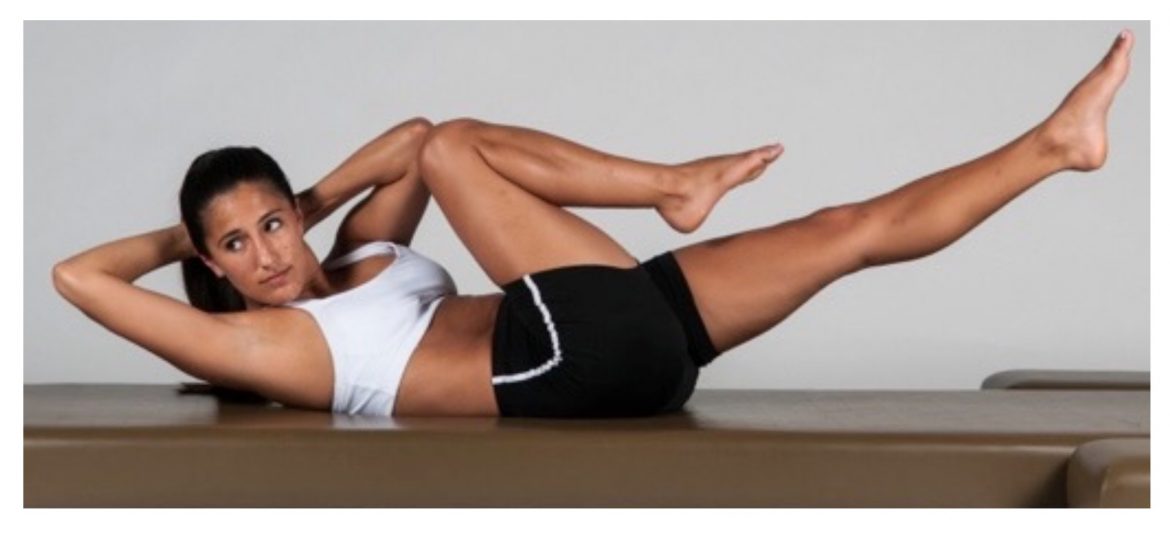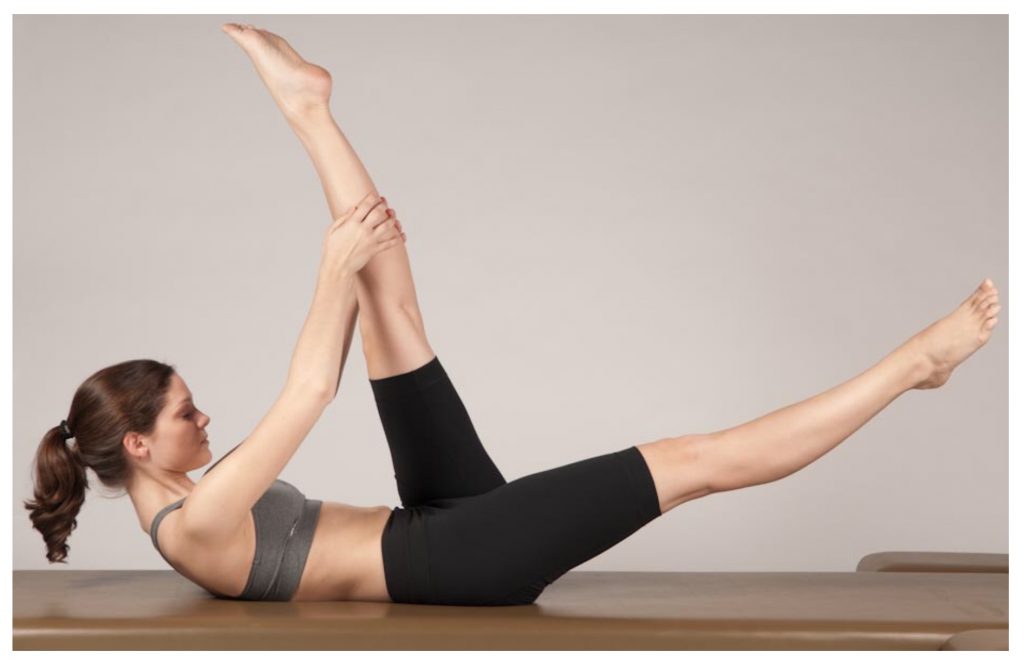 The Pilates Mat Abdominal Series consists of two exercises at the beginner level and the addition of three more for a total of five exercises at the intermediate/advanced level.
The Pilates Mat Abdominal Series consists of two exercises at the beginner level and the addition of three more for a total of five exercises at the intermediate/advanced level.
All five Pilates Mat Abdominal Series exercises are performed with the client supine.
- Lower Body
- All five Pilates Mat Abdominal Series exercises are performed with one or both legs brought up into the air (technically termed flexion of the thigh at the hip joint).
- Upper Body
- In all five Pilates Mat Abdominal Series exercises, the head, neck (cervical spine), and upper trunk (upper thoracic spine) are flexed off the mat.
(Note: All photo credits: The Art of Control.)
The five Pilates Mat Abdominal Series exercises are:
- Single Leg Stretch
- Double Leg Stretch
- Single Straight Leg Stretch
- Double Straight Leg Stretch
- Criss-Cross
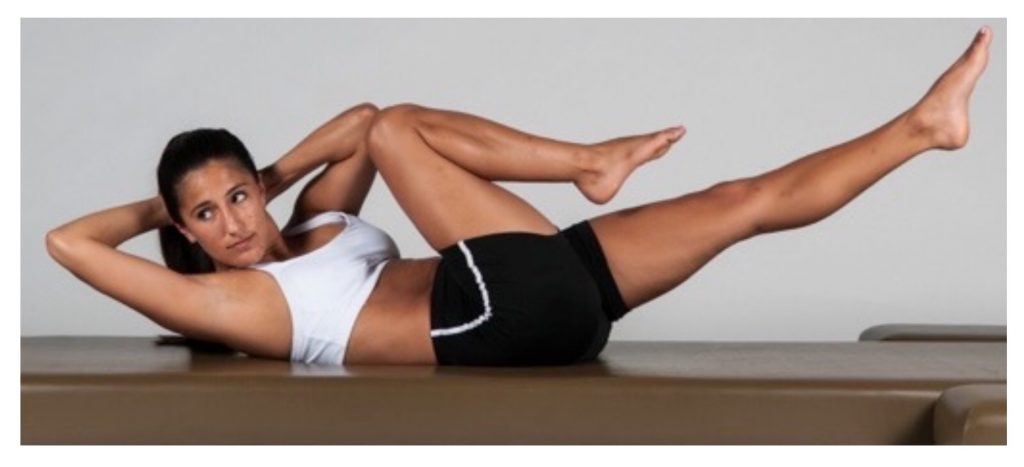 Biomechanics of the Pilates Mat Abdominal Series – Lower Body
Biomechanics of the Pilates Mat Abdominal Series – Lower Body
When a lower extremity is brought up into the air, which is termed flexion of the thigh at the hip joint (a sagittal plane motion), this places two demands on the body.
- The first demand is that the hip flexor muscles must contract. More specifically, the hip flexors must
- contract concentrically to bring the leg into flexion
- contract isometrically for any length of time that the thigh is held statically in flexion
- contract eccentrically as the thigh is slowly brought down into extension back toward the mat
- Hip Flexors
Following are the muscles that flex the thigh at the hip joint:
Note: All flexors of the thigh at the hip joint are also anterior tilters of the pelvis at the hip joint
- Gluteus Minimus (anterior fibers)
- Gluteus Medius (anterior fibers)
- Tensor Fasciae Latae (TFL)
- Rectus femoris (of the quadriceps femoris group)
- Sartorius
- Iliacus
- Psoas Major
- Pectineus
- Adductor Longus
- Gracilis
- Adductor Brevis
- Adductor Magnus (anterior head)
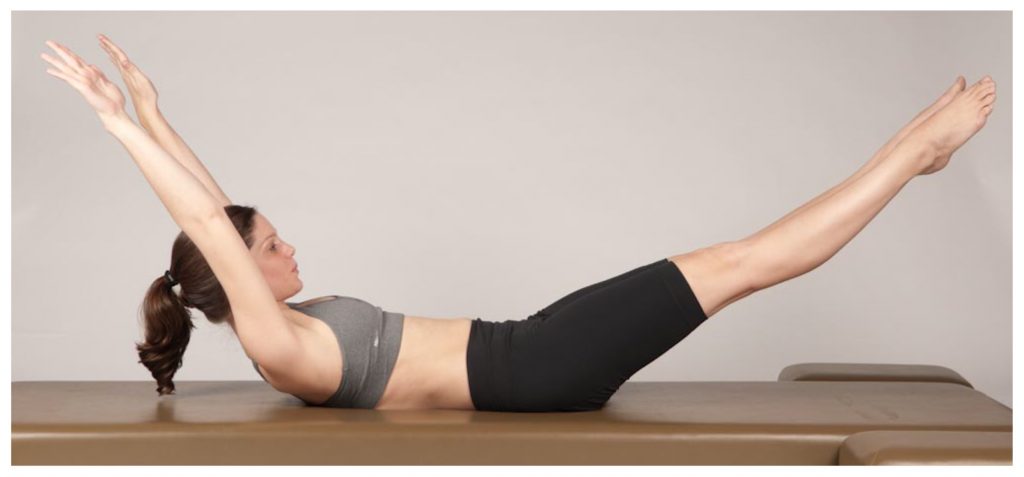
- The second demand is that the muscles of the anterior abdominal wall must isometrically contract to stabilize the pelvis.
- Because hip flexors also pull upon the pelvis, pulling it toward anterior tilt in the sagittal plane; the pelvis must be stabilized to prevent it from anteriorly tilting (because excessive anterior tilt would cause the lumbar lordotic curve of extension to increase, thereby jamming the facet joints into each other).
- Anterior tilt of the pelvis is prevented by a force of posterior tilt.
- All anterior abdominal wall muscles that have any vertical component to their direction of fibers can create a pull of posterior tilt in the sagittal plane.
- These are the rectus abdominis, external abdominal oblique, and internal abdominal oblique.
- The transversus abdominis does not contribute to sagittal plane stabilization of the pelvis. However, it is cued to contract by the Pilates instructor to prevent the belly (anterior abdominal wall) from bulging outward. If the belly were to bulge outward, it would in effect be “bowstringing,” which would weaken the pull of the sagittally oriented anterior abdominal wall muscles.
- The degree of demand placed on the hip flexors and anterior abdominal wall muscles is determined by the leverage force of the weight of the lower extremity or extremities that is/are flexed off the mat. This can be affected three ways:
- If both thighs are flexed, then the demand is doubled compared to having only one thigh flexed. This is why single leg stretch is easier and done first before double leg stretch.
- If the knee joint is straight (i.e., the knee joint is fully extended), then the effective leverage force of the center of weight of the lower extremities is farther from the hip joint (the axis for motion) and is therefore greater. This is why the single and double straight leg stretch exercises are more challenging and only performed at the intermediate and advanced levels.
- The height of the lower extremities off the mat also affects the leverage force of the lower extremity weight and therefore the demand on the body. Leverage force increases when the force is farther from the axis of motion, in other words farther from the joint, in this case the hip joint. The lower/closer to the mat the lower extremities are, the farther the center of weight is from the hip joint and therefore the more challenging is the exercise. If instead the thighs were flexed all the way to ninety degrees, so that the thighs are perfectly vertical in the air, the center of weight of the lower extremities would be essentially right over the joint and the leverage force would zero or nearly zero.
- Other Lower Body Considerations of the Pilates Mat Abdominal Series…
- Single Leg Stretch and Single Straight Leg Stretch also help to mobilize the sacroiliac and pubic symphysis joints. When a thigh flexes, by femoropelvic rhythm that side pelvic bone tends to posteriorly tilt. When the thigh extends, by femoropelvic rhythm that side pelvic bone tends to anteriorly tilt. Therefore, if one thigh is flexing as the other thigh extends, then one pelvic bone is posteriorly tilting as the other pelvic bone anteriorly tilts. This causes motion to occur at the joints between the pelvic bones, in other words the sacroiliac and pubic symphysis joints.
- Double Leg Stretch also helps to expel air from the body when the knees are brought in against the abdominopelvic cavity because the abdominal contents are compressed, pushing up against the diaphragm, thereby compressing the lungs and expelling air.
- A common modification for the Single and Double Leg Stretch exercises for a client with a knee pathology who cannot fully flex the knee joint is to grasp the lower extremity on the posterior (backside of the) distal thigh instead of on the anterior (front side) of the (lower) leg.
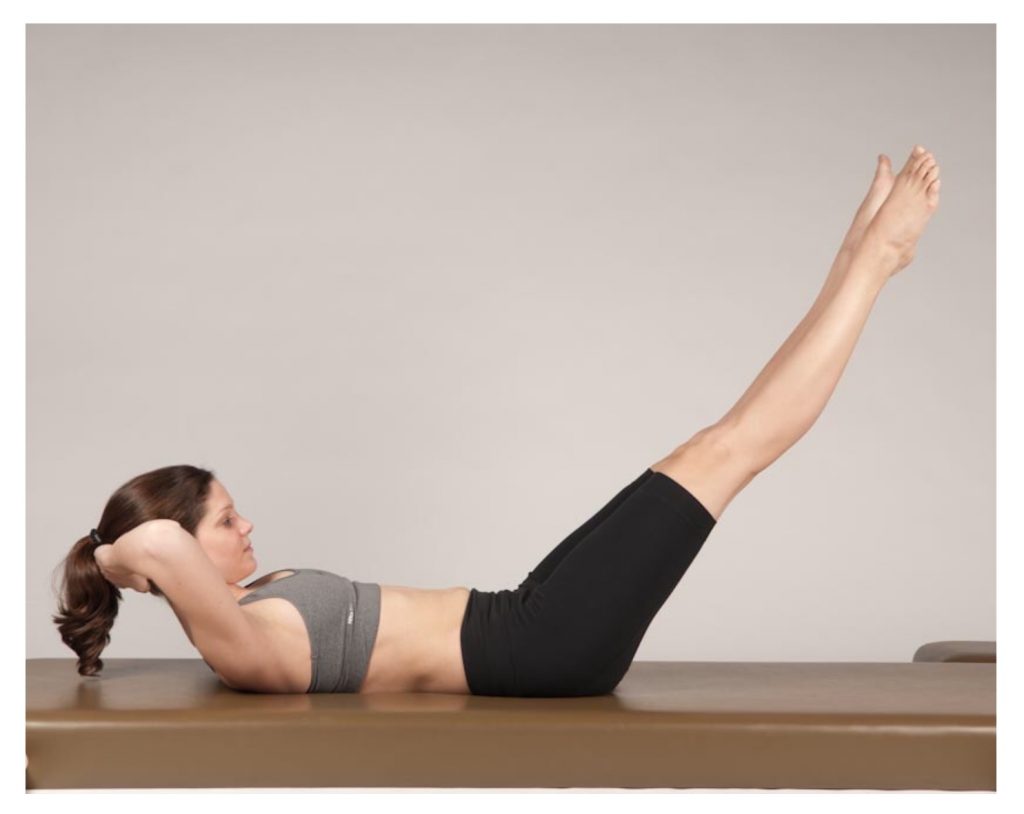 Biomechanics of the Pilates Mat Abdominal Series – Upper Body
Biomechanics of the Pilates Mat Abdominal Series – Upper Body
When the head, neck, and upper back are flexed off the mat, the following biomechanics occur:
- Flexors of the head and neck must isometrically contract to hold the static position of neck/head (cervicocranial) flexion.
- There are three major muscle groups of cervicocranial flexion. They are the sternocleidomastoid (SCM), the scalenes (anterior, middle, and posterior scalenes), and the longus muscles (longus colli and longus capitis).
- It is important for the client to use the deeper longus muscles, and secondarily to use the scalenes to flex the neck and head; and to not engage the SCM.
- Over engagement of the SCM would create flexion of the lower neck but would also create extension of the head (at the atlanto-occipital joint); this would manifest as “leading with the chin.” Extension of the head would jam the facet joints of the atlanto-occipital joint. This postural dysfunction pattern is part of a larger postural dysfunction pattern known as upper crossed syndrome (named by Vladimir Janda, a Czech physiologist).
- For this reason, the client should gently tuck the chin with these exercises.
- The hands gently support the head during the Double Straight Leg Stretch and the Criss-Cross exercises, which decreases the demand placed on the cervicocranial flexor muscles. This small relief for these muscles is welcome given that these are the two most challenging Abdominal Series exercises for the hip flexors and anterior abdominal wall muscles.
- When the hands are behind and supporting the head with the Double Straight Leg Stretch and Criss-Cross exercises, the elbows should be oriented to the side. If the elbows are too far back, it would require shoulder girdle retraction, which would be uncomfortable when coupled with the upper thoracic spinal flexion. If the elbows are too far forward, it would require excessive shoulder girdle protraction, which would increase the tendency of the postural distortion pattern of rounded shoulder girdles of upper crossed syndrome.
- With Double Straight Leg Stretch, the arms perform a larger flexion and arc-like motion. The fuller flexion of the arms over the head helps to lengthen the body in opposition. As the lower extremities reach out away from the core, the upper extremities also reach out away from the core, but in the opposite direction.
- A common modification during the Abdominal Series exercises is for the client to either lay their head on the mat or on a pillow (except for the Criss-Cross, which requires flexion of the head/neck/upper trunk).
- As a rule, the inferior angles of the scapulas should remain on the mat for all five of the Pilates mat Abdominal Series exercises. We are looking for flexion of the head/neck/upper thoracic spine, not excessive flexion of the entire trunk. (Note: the inferior angles of the scapula can and do lift off the mat when the Criss-Cross is done more powerfully.)
- Upper body flexion also places a demand on the anterior abdominal wall musculature.
- Holding the position of flexion of the head/neck/upper back (cervicocranial and upper thoracic spine) requires an isometric contraction of the sagittal plane musculature of the anterior abdominal wall, adding to the lower body demand upon these muscles to isometrically contract to stabilize the pelvis.
- This upper body flexion also places a demand on the intercostal muscles of the anterior rib cage, which assist in thoracic spinal flexion.
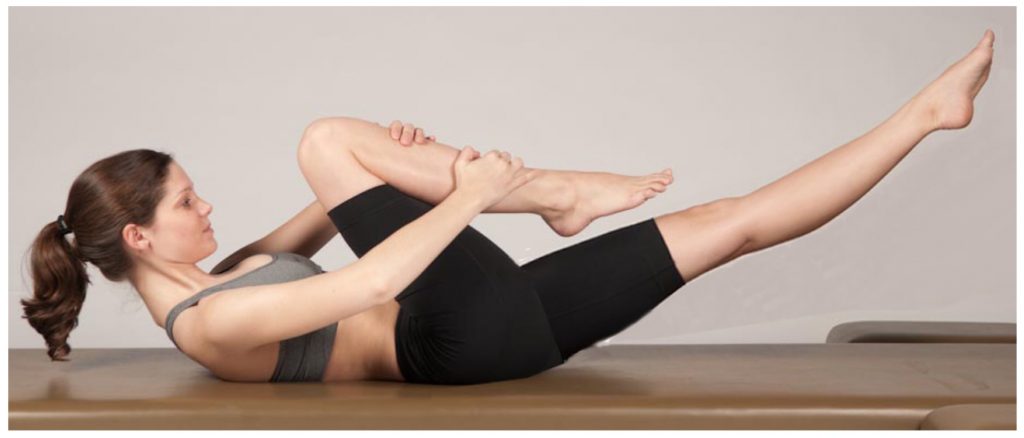 Other Upper Body Considerations…
Other Upper Body Considerations…
- Flexion of the spine is a natural and healthy movement, but has fallen into disfavor in recent years.
- This is because spinal flexion increases compression force into the anterior aspect of the discs, driving the nucleus pulposus posteriorly against the posterior fibers of the annulus fibrosus, as they are being pulled taut.
- Therefore, excessive flexion postures and motions may cause disc disease (annular bulging and/or herniation/rupture).
- Having said this, strengthening anterior abdominal wall musculature also helps to stabilize the lumbar spine and therefore the lumbar spinal disc and facet joints.
- Further, spinal flexion also increases the size of the intervertebral foramina (IVF, the holes through which the spinal nerves enter/exit the spinal cord in the spinal canal) and also unloads the facet joints.
- As with all things, it is important to balance all postures and motion patterns.
- Pilates mat exercises are fairly flexion-dominant, so as the client strengthens, their regimen should be balanced with other exercises that favor spinal extension.
- Further Considerations of the Pilates Mat Criss-Cross Exercise…
- Criss-Cross is the most challenging of the five Abdominal Series exercises because it introduces a transverse plane rotational component to the body.
- Therefore, the external and internal abdominal obliques are preferentially engaged instead of the rectus abdominis.
- Other spinal rotation musculature, such as the posterior spinal transversospinalis musculature, especially the rotatores and multifidus, is engaged as well.
- The Criss-Cross should not introduce frontal (coronal) plane motion/instability. To prevent this, the client’s elbows should remain in the middle of the body; as one elbow rotates forward, the other rotates backward. Picture the rotation occurring around the vertical (superoinferior) axis that runs through the center of the head and spine.
- It is not necessary for the elbows to meet the knees during the Criss-Cross exercise. If the client is very flexible and this occurs easily, that is fine. But we are not looking to overly increase trunk flexion. Although the Criss-Cross resembles a rotational abdominal crunch exercise that is typically performed in the world of fitness at the gym, the Criss-Cross is not primarily aimed at increasing trunk flexion. Its primary aim is to introduce rotational mobility and therefore rotational stability to the thoracic spine, as the anterior abdominal wall (lumbar region) musculature maintains stabilization of the pelvis in the sagittal plane.
- It is extremely important that the client is strong and stable before attempting the Criss-Cross exercise because any excessive or poorly stabilized lumbar rotation may cause low back pain and dysfunction due to excessive stress placed upon both the disc and facet joints. The lumbar spine only allows one degree of rotation to each side at each segmental joint level, so the lumbar spine should not be overly loaded into rotation.
- Therefore, it is important to emphasize to the client that when performing the Criss-Cross exercise, the trunk rotation should initiate from the upper thoracic region and then descend into the middle and lower thoracic region, and then into the lumbar region. The lumbar spine should not be overly moved/stressed into rotation; and the pelvis should remain in place on the mat.
 Finding Your Pilates Instructor
Finding Your Pilates Instructor
Finding the right Pilates Instructor is of paramount importance!
Generally, Traditional Pilates Instructors have been trained with the most thorough and rigorous Certification Program, usually 600+ hours! They learn the full Mat and Apparatus training regimen as Joseph Pilates taught it.
A well-trained and experienced Pilates Instructor is also important so that she or he can not only choose the right exercises to challenge your body’s strength, mobility, and proper neural/motor movement patterns, but can also can modify each exercise as appropriate for your body.
There is an old saying the world of Pilates:
“It is not how many; it is how.”
In other words, it is about the quality of the movement.
Finding Your Pilates Teacher Training Certification Program
- An excellent Traditional Pilates Certification Training Program centered in the New York City metropolitan area, and taught around the United States and the World, is The Art of Control’s Art and Science of Contrology Instructor Training Program
- Note: The Art of Control is directed by Simona Cipriani, a second-generation Pilates Instructor who trained with Romana Kryzanowska, Joseph Pilates’s protégé, who took over and ran Joseph Pilates’ gym after he passed away.
- Click here for more information on Simona Cipriani and The Art of Control
Looking for more Exploration into the Biomechanics of Pilates Exercises?
- The Art and Science of Kinesiology’s Digital COMT (Clinical Orthopedic Manual Therapy) has a video library of in-depth explorations of Pilates exercises. For each exercise, variations and modifications are demonstrated and explained, as well as clear explanations of the biomechanics of the exercise.
- Digital COMT is a video streaming subscription service that covers all facets of manual and movement therapies!
- Click here for more information on Digital COMT.
- The Art and Science of Kinesiology is directed by Joseph E. Muscolino DC.
- Click here for more information on Joseph Muscolino and The Art and Science of Kinesiology


